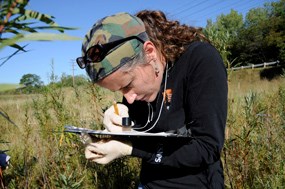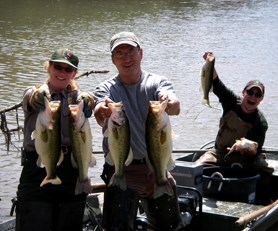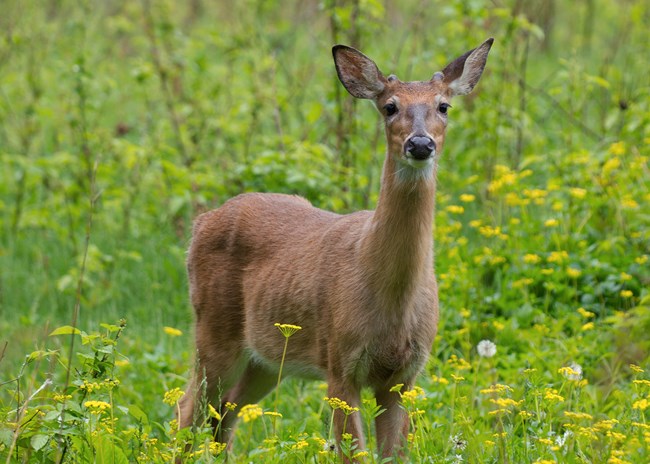|
Cuyahoga Valley National Park (CVNP) has many natural resources, including its wildlife, plants, and water. The job of park scientists is to preserve CVNP’s natural resources for future generations. Park scientists do this by keeping a watch on, or monitoring, those natural resources. They track plant and animal populations, see if the Cuyahoga River is getting cleaner, and scientifically study how to best restore habitats. What park scientists learn helps keep CVNP’s wildlife, plants, and water as healthy and natural as possible. 
NPS/Ted Toth Who Are They? Gathering scientific information takes time and people-power. Citizen scientists do a lot of data collecting in CVNP. These nature-loving volunteers count migrating songbirds, butterflies, frogs by their calls, spongy moth eggs masses, deer pellets, and plants in experimental study plots. What Do They Do? 
NPS Collection Some animals are easier to count than others. The kinds and numbers of birds or butterflies in a field are pretty easy to see, identify, and count. Fish aren’t so easy. Park scientists count fish in the Cuyahoga River by shocking them. A mild current from an electro-shocker in the water stuns the fish. They stop swimming and float up to the surface where they can be easily seen. The fish quickly recover from the stun and swim away, so scientists have to count fast! Nocturnal animals can also be hard to see and count—like coyotes. Park scientists track their numbers by playing recorded coyote calls at night. Then they listen—and count—how many coyotes call back. 
NPS/Arrye Rosser What Are Some Environmental Issues in CVNP? Many non-native plants, like garlic mustard and autumn olive have become harmful invasive plants in CVNP. They grow quickly, overtaking native plants that wildlife needs to survive. Citizen scientists are helping control these pest plants. Volunteers adopt areas of the park chosen by park scientists for invasive plant removal. They clear out the problem plants and keep checking back on their adopted area year after year until every invasive plant is gone for good. 
©Jerry Jelinek Deer are another problem-causing population that scientists at CVNP are keeping an eye on. Park scientists and volunteers track the number of deer in a number of ways. They count fecal pellets, do aerial surveys, and also shine spotlights along park roadways to count deer out at night. As many as 130 deer lived within every square mile of CVNP prior to implementing our Deer Management Program. That’s ten times more than an ecosystem can support without damage. Resource managers are studying how the deer are changing the mix of forest plant species at CVNP. They are seeing fewer seedling trees, wildflowers, and other plants that deer eat. Their findings have been used to help decide how to better manage the deer population in the future. Currently, there are approximately 16-30 deer per square mile throughout the park's five management zones. Water pollution is another environmental issue that CVNP scientists are working on. The water quality of the Cuyahoga River is continually tested. The good news is that it’s getting better! Park scientists are working with nearby communities to help prevent pollution from ever entering the river. Park scientists are also working with the U.S. Geological Survey to come up with a way to quickly know the levels of water-polluting sewage in the river. Then visitors can be told if the Cuyahoga is safe for boating or swimming that same day. 
NPS/Ted Toth |
Last updated: June 21, 2023
